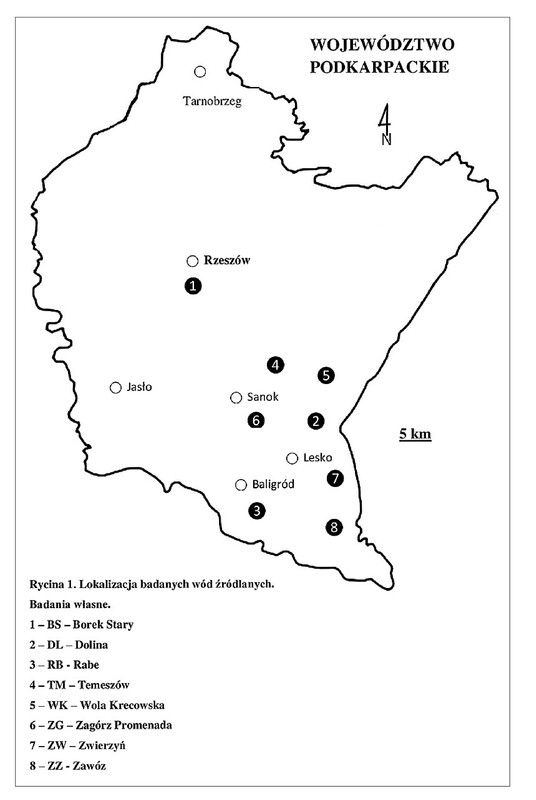RESEARCH PAPER
Analysis of trace elements in spring waters of the Subcarpathian Province – Effect of selected Miraculous Springs on eye therapies
1
High school, School Complex No. 2 named after Grzegorz of Sanok, Polska
2
Hospital, Specialist Hospital in Brzozów. Podkarpackie Oncology Center, Polska
Corresponding author
Andrzej Łach
Szkoła średnia, Zespół Szkół nr 2 im. Grzegorza z Sanoka, Stróżowska 15, 38-500, Sanok, Polska
Szkoła średnia, Zespół Szkół nr 2 im. Grzegorza z Sanoka, Stróżowska 15, 38-500, Sanok, Polska
Med Srod. 2025;28(3):91-97
KEYWORDS
TOPICS
ABSTRACT
Introduction and objective:
Trace elements, such as zinc, copper, manganese, and selenium are all components of metalloenzymes. Specific enzymes and their metal connections with antioxidant activity are detailed. Oxidative stress, which results in diseases and visual impairments, is partly caused by deficiencies in the trace elements mentioned above. The objective of this study was to experimentally determine whether there is a difference in chemical composition between the so-called Miraculous Springs and other groundwater sources. Different chemical characteristics and the resulting medical properties could suggest that the Miraculous Springs indeed have spectacular (miraculous) healing effects on the eyes.
Material and methods:
Eight groundwater springs were examined—four identified as ‘miraculous’ and four as ‘control group’. In each water sample, the listed metals were analyzed using the ICP-OES method. The examined springs are located across the entire Subcarpathian Province, including the Bieszczady Mountains.
Results:
Based on instrumental analysis, statistical testing, daily human dietary requirements, and the concentrations of the trace elements of interest in the spring waters, it was demonstrated that the chemical composition—and thus the medical properties—of the waters from the Miraculous Springs do not differ from those of other groundwater sources.
Conclusions:
The absence of differences between the ‘miraculous’ and ‘control group’ waters, as well as the consistently low concentrations of the analyzed metals in all water samples, excludes the former from being classified as therapeutic. It can be concluded that from the perspective of physics, chemistry, or medicine, the Miraculous Springs do not possess healing (miraculous) properties for eye therapy—unless such effects are based on the strong religious beliefs of pilgrims (legendary miracles).
Trace elements, such as zinc, copper, manganese, and selenium are all components of metalloenzymes. Specific enzymes and their metal connections with antioxidant activity are detailed. Oxidative stress, which results in diseases and visual impairments, is partly caused by deficiencies in the trace elements mentioned above. The objective of this study was to experimentally determine whether there is a difference in chemical composition between the so-called Miraculous Springs and other groundwater sources. Different chemical characteristics and the resulting medical properties could suggest that the Miraculous Springs indeed have spectacular (miraculous) healing effects on the eyes.
Material and methods:
Eight groundwater springs were examined—four identified as ‘miraculous’ and four as ‘control group’. In each water sample, the listed metals were analyzed using the ICP-OES method. The examined springs are located across the entire Subcarpathian Province, including the Bieszczady Mountains.
Results:
Based on instrumental analysis, statistical testing, daily human dietary requirements, and the concentrations of the trace elements of interest in the spring waters, it was demonstrated that the chemical composition—and thus the medical properties—of the waters from the Miraculous Springs do not differ from those of other groundwater sources.
Conclusions:
The absence of differences between the ‘miraculous’ and ‘control group’ waters, as well as the consistently low concentrations of the analyzed metals in all water samples, excludes the former from being classified as therapeutic. It can be concluded that from the perspective of physics, chemistry, or medicine, the Miraculous Springs do not possess healing (miraculous) properties for eye therapy—unless such effects are based on the strong religious beliefs of pilgrims (legendary miracles).
REFERENCES (28)
1.
Pytka P. Holy Springs in Bieszczady Mountains – valuable culture–landscape objects. Ann UMCS. Sectio B. Geograp Geol Mineral Petrograp. 2005; VOL. LX: 9.
2.
Fedor M, Urban B, Bakunowicz-Łazarczyk A. Rola pierwiastków śladowych w patogenezie i progresji krótkowzroczności. Okul Dypl. 2015;5(27):12–16.
3.
Kubasik M, Bogdański P, Suliburska J. The influence of minerals in the pathogenesis of obesity and its complications. For Zab Metabol. 2018;9(4):141–151.
4.
Nowak JZ. Okulistyczne preparaty antyoksydacyjne – przegląd i uzasadnienie ich stosowania w AMD. Magazyn Lekarza Okulisty. 2010;4(4):185–198.
5.
Mrowicka M, Mrowicki J, Szaflik J. Evaluation pro/antioxidant balance in patients with wet form of age-related macular degeneration. Klinika Oczna. 2016;118(4):284–288.
6.
Dróżdż-Afelt K, Koim-Puchowska M, Menka A. Wybrane pierwiastki śladowe w organizmie człowieka. Kosmos. Probl Nauk Biol. 2019;68(3) (324):503–512.
7.
Wołonciej M, Milewska E, Roszkowska-Jakimiec W. Trace elements as an activator of antioxidant enzymes. Postępy Hig Med Dośw. 2016;70:1483–98.
8.
Huibi X, Kaixun H, Qiuhua G, et al. Prevention of Arial elongation in myopia by the trace element zinc. Biol Trace Elem Res. 2001;79:39–47. doi:10.1385/BTER:79:1:39.
9.
Wikarek-Paluch E, Rosik-Dulewska Cz. Biodostępność wybranych zanieczyszczeń w gruntach zdegradowanych chemicznie. Zabrze: Instytut Inżynierii Środowiska PAN; 2020.
10.
Kołomański J, Wegenko C. Characteristics of manganese and its compounds AT various deggrees of oxidation with particular reference to potassium manganate (VII). Acta Juvenum. 2018;3:103–108.
11.
Jarosz M. Normy żywienia dla populacji Polski. Warszawa: Instytut Żywności i Żywienia; 2017.
12.
Kaczmarski M, Chorostyński A, Łach A, et al. Ananalysis of bioelements in the source waters of Sanok District on the border of the Eastern and Western Carpathians and their impact on the functioning of the human body. Rocznik Ochro Środow. 2019;21:926–950.
13.
Banaszczyk K, Maliszewska A, Owsiany M. The role of selenium in the treatment of Hashimoto’s disease. Pediatr Med Rodz. 2019;15(2):125–130. doi:10.15557/PiMR.2019.0021.
14.
Borek Stary. Narodowy Przewodnik po Cudownych Źródełkach. http://www.cudownezrodelka.pl/... (access: 2024.05.19).
16.
Adamska M, Pasztyła G, Wachel T. Pierwiastki śladowe: arsen-trucizna czy lek? Analiza wody z Rabe cz. III. Laboratoria, Aparatura, Badania. 2021;26(4):22–26.
17.
PETROGEO. Przedsiębiorstwo Usług Laboratoryjnych i Geologicznych, Sp. z o.o. Wołomin. Oddział Laboratorium Geologii i Badań Środowiska w Jaśle. 2025. Akredytacja Nr 1185. Zleceniodawca Andrzej Łach. Raport nr LJ/1046-1047/A/458-458/25. LJ/1294-1296/A/565-567/25. LJ/1498-1501/A/658-660/25.
18.
Szczepaniak W. Metody instrumentalne w analizie chemicznej. Warszawa: Wydawnictwo Naukowe PWN; 2019.
19.
Gajec M, Król A, Kukulska-Zając E. Determination of metals in selected elements of the environment in the context of applicable legal regulations. Nafta-Gaz. 2019;5:283–292. doi:10.18668/NG.2019.05.06.
20.
Rozporządzenie Ministra Gospodarki Morskiej i Żeglugi Śródlądowej z dnia 14 października 2019r. w sprawie kryteriów i sposobu oceny stanu jednolitych części wód podziemnych. DzU2019.2148.
21.
Żurek K, Samek A, Jakubas M. Determination of the elements Na, Mg, Fe, Cr, Mn, Zn in water and lake silt samples by the Atomic Absorption Spectrometry (AAS) method. Analit. 2021;10:46–57.
22.
Grabowska K, Kałuzińska K. Determination of iron and manganese concentrations in water of the selected public artesian wells in Cracow. Analit. 2020;9:2–11.
23.
Ośko J, Pierlejewska W, Grembecka M. Comparison of the Potential Relative Bioaccessibility of Zinc Supplements – In Vitro Studies. Nutrients. 2023;15(12):2813. doi:10.3390/nu15122813.
24.
Kulik A. Wpływ miedzi, cynku i selenu na stan skóry. Pol Hyp Res. 2023;2(83):23–30.
25.
An Y, Li S, Huang X, et al. The Role of Copper Homeostasis in Brain Disease. Int J Mol Sci. 2022;23(22):13850. doi:10.3390/ijms232213850.
26.
Chorostyński A, Łach A, Paszytła G. Physico-chemical parameters and bacteriology of mineral and sulphate Walters discovered around Sanok and Lesko, and the prospects for their medicaluse. Acta Sci Pol Formatio Circumiectus. 2018;17(1):113–126.
27.
Kondraciuk J, Łukawski K. Neurotoksyczność manganu. Med Środow – Environ Med. 2023;26(3–4):43–48. doi:10.26444/ms/172390.
28.
Muszyńska B, Bednarska-Łojewska D, Zięba P. Znaczenie selenu w diecie człowieka-w aspekcie żywienia zwierząt hodowlanych. Rocz Nauk Zoot. 2018;45(2):135–142.
We process personal data collected when visiting the website. The function of obtaining information about users and their behavior is carried out by voluntarily entered information in forms and saving cookies in end devices. Data, including cookies, are used to provide services, improve the user experience and to analyze the traffic in accordance with the Privacy policy. Data are also collected and processed by Google Analytics tool (more).
You can change cookies settings in your browser. Restricted use of cookies in the browser configuration may affect some functionalities of the website.
You can change cookies settings in your browser. Restricted use of cookies in the browser configuration may affect some functionalities of the website.



